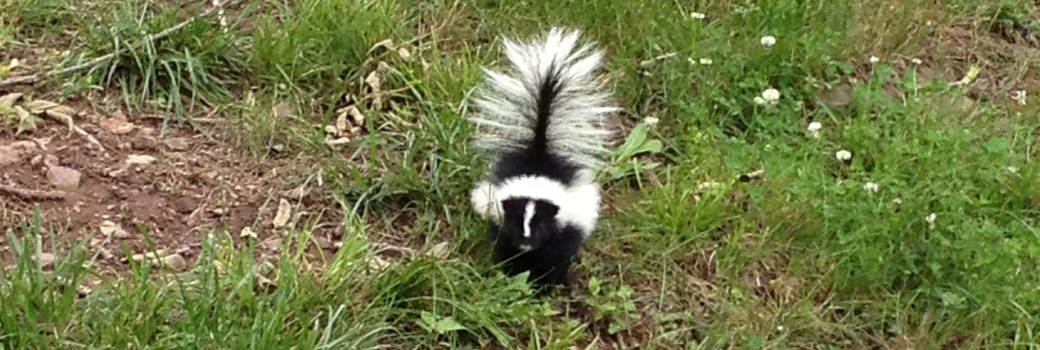- Westchester Educational Article of the Month - About Skunk: Appearance, biology, life cycle, habitat, diet, behavior
About Skunk: Appearance, biology, life cycle, habitat, diet, behavior
The skunk is probably one of the most well-known animals in the world. Because of the way in which skunks defend themselves they have become the one animal that no one wants to be around, even other skunks.
The New York skunk is a primarily black animal with two white stripes down its back that end in the tail. The critter can range in size from 15.6 inches to 37 inches in length and can weigh as little as 1.1 pounds and as much as 18. The skunk has a body length much like that of a cat, and they have very well-muscled legs with long claws on their front paws.
While the vast majority of skunks are black and white, there are many that have a gray or brown color. Some are even cream-colored, but those are quite rare.

Skunks are omnivores, in that they will eat virtually anything. They frequently change their diet based upon the season. As spring hits and there are more food sources available, skunks will eat a lot more insects, especially in the larval stages. They will also eat lizards, rodents, frogs, birds, and moles. They enjoy eating the eggs of other Westchester animals, and will frequently wait for parents to leave a nest and then sneak in and take eggs and eat them.
They also will eat many different kinds of New York berries, nuts, grasses, leaves and nuts. Skunks will indulge on some fungi and algae if they are near a river or pond.
If a skunk is located near a populated area they are more than willing to enter a Westchester citizen's garbage can and help themselves. They will act as scavengers if the opportunity arises. If a skunk can find its way into a home to get food it is more than willing to do so. There is no fear of human beings here at all.
Interestingly enough skunks are one of the earth’s primary predators of bees. Because of the thick coating on their fur they are able to fight off the stings of bees. They will tear open a beehive and eat the bees that come out to defend their home. It is a very interesting situation.
Skunks prefer to live a solitary life. They will spend time with another skunk to mate, but otherwise are found by themselves most often. In colder areas they will share a den with other skunks solely for warmth.
Skunks are able to dig burrows and dens with their very sharp claws. They often stay in these during the day and hunt during the Westchester night. A skunk is not sedentary however. While they build homes they will move frequently. In a year’s period of time many skunks are known to cover as much as 20 square kilometers of land.
While not true hibernators, skunks will stay hold up for long periods of time during the New York winter. During this dormant stage they do not eat. Males live alone during these dormant periods, but females will congregate together in groups of as many as 12.
One of the reasons that skunks hunt at night is that they have extremely poor vision but great hearing and sense of smell. The enhanced senses make hunting at night much more advantageous for them. The fact that they cannot see and rely so much on hearing and smell make them an easy target when they venture onto the road. They frequently do not notice cars until well after it is too late.
Skunks can have several mates in a reproductive season, but only reproduce in the spring. The period a young New York skunk is in the mother is usually about 60-70 days. Prior to the birth the mother digs a den where she will lay her litter. A typical litter is four to seven kits.
The kits are weaned from their mother at two weeks, and are able to open their eyes at about three weeks. They will stay with their mother until they are ready to mate, which is when they are about one years old. The mother is completely responsible for the care of the kits.
The most common and notorious feature of the skunk is the anal scent glands. These glands are for defense, and secrete an incredibly pungent smelling liquid that virtually all other animals find absolutely repugnant. This smell is pungent enough to scare off animals like bears and lions. They are able to spray their enemies with great accuracy, and once sprayed an animal finds it very hard to remove the smell. The odor can be smelt for more than a mile away by most animals.
Most animals are naturally aware that they should stay away from skunks. If they come anywhere near the creatures they will run away out of fear of being sprayed. It is one of the best defenses in nature.
To learn more about our services, visit the Wildlife removal Westchester home page.

